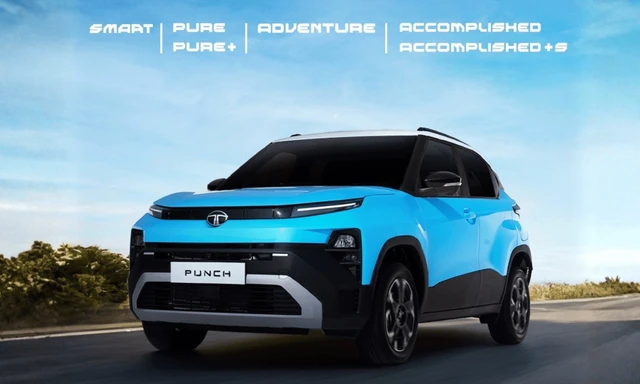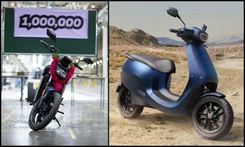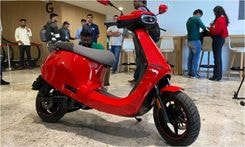EV Fires: Reasons & The Way Forward For Electric Scooters

With a spate of incidents in India of electric scooter fires, there's been a growing debate and discussion about the safety of mushrooming EV brands and quality control of products. The discussion has become even more heated with back-to-back incidents of electric scooters catching fire across India over the past week. But what causes a fire in an electric two-wheeler, and how difficult is it to prevent a fire caused by a short-circuit in the electrical system and battery? carandbike reached out to experts in India's electric vehicle ecosystem, including battery cell manufacturers, EV OEMs and others, to get a sense of what exactly is going wrong in the booming EV segment.
Focus on Safety
With incidents of fire reported across electric scooters from Ola Electric, Okinawa and Pure EV in recent days, resulting in the tragic deaths of one EV owner and his teenaged daughter, the Government of India has now deputed an independent team to probe the incidents and to submit a report. The idea is to develop new standard operating procedures (SOPs), formulate new safety guidelines and possibly even new regulations around the types of batteries, battery management systems and cells used in many electric two-wheelers.
In all four cases reported over a period of four days, the electric scooters seem to have spontaneously erupted into thick smoke, and then fire. In the incident involving an Okinawa electric scooter, the fire spread to a petrol-powered motorcycle, and the father and daughter were trapped inside their house, leading to their tragic deaths. Preliminary reports indicate improper use of an older charging socket which possibly led to a short-circuit, leading to the fire. The causes of fire in the other scooters are not clear, although both Pure EV and Ola Electric are conducting their own investigations and are expected to report their findings.
But these rising incidents have put the spotlight squarely on EV safety, quality control and related safeguards with regards to battery packs and battery management systems. A section of industry observers maintain that the EV fires are caused by cells and the battery designs since these are not designed for high temperatures and the terrain the typical Indian consumer uses EVs in. But it's more than just battery design or faulty battery management systems (BMS) which cause such fires, as carandbike found out. There's also the larger question of the quality of EVs being launched almost every day in the market, and if there are enough checks and balances to regulate safety and prevent hazardous incidents like fire.
Thermal Runaway & Cell Chemistry
Thermal runaway is the rapid and extreme rise in temperature in a cell of the battery. When cells heat up and initiates the same reaction in adjacent cells, it is known as thermal runaway propagation. When thermal runaway happens, it can produce smoke, fire and even explosions, all tell-tale signs of the recent electric scooter fires.

Arun Vinayak, Co-Founder, Exponent Energy and ex-CPO at Ather Energy.
According to Arun Vinayak, Co-founder and CEO of Exponent Energy, a battery and charging technologies provider for the EV market, 99 per cent of battery fires are caused due to short circuits, which lead to the battery cell's temperature rising leading to what is called a thermal runaway. Vinayak, who was also one of the co-founders and Chief Product Officer of Ather Energy, says short circuits happen for either poor cell quality, poor physical design of the battery, and a poor battery management system (BMS).
undefinedLet's talk about a burning topic: Battery safety ????
— Arun S Vinayak (@Arun_Vinayak_S) April 1, 2022
Firstly, let's get this misconception out of the way — summer and bad thermal management don't lead to battery fires☀️????https://t.co/ZZIfjmFWMW - a deep dive into why batteries catch fire. pic.twitter.com/gkQdwN7hdU
Log9 Materials is another Bengaluru-based start-up in the field of advanced battery technology. The company was founded in 2015 at IIT Roorkee by three friends and is now working on developing advanced energy storage technologies. Speaking to carandbike, Log9 Materials Co-founder Kartik Hajela said that the circumstances of EVs catching fire are primarily due to two broad reasons - battery chemistry and use of improper charging infrastructure.
"One of the reasons is that many of the players in the Indian EV segment have products which are not re-engineered properly. The cell chemistry of the batteries must be re-grouped and made temperature resilient to be efficiently operational in our climate conditions and terrain. Having the proper cell chemistry means to have efficient thermal management systems, and to have resilient technology," said Hajela.
"The EV segment will consolidate, but right now amongst the OEMs there are those who are in the trading business, using re-branded products rather than using proper re-engineering and innovation in product development. It's not to say that all players are like that; there are some OEMs which have engineered their products well and have gone through a significant R&D and testing cycle. But there are also others where the fundamental aspects of safety and good user experience are overlooked. These cause problems. And then the charging infrastructure has also not kept pace with EV sales. In fact, home charging should not be promoted, unless there is tailor-made charging infrastructure. The technology should advance for dedicated fast charging rather than just promoting home charging on conventional sockets," added Hajela.

Kartik Haleja, co-founder of Log9 Materials.
Focus on Cell Selection, Quality & Packaging
There's also the issue of the quality of cell selection and quality checks. According to some observers, short circuits also happen due to the grading of cells, how they are sorted, the kind of connectors used in the batteries, and finally, the design of the battery pack itself. Oben Electric, a Bengaluru-based electric vehicle start-up has launched its first electric motorcycle, the Oben Rorr.
"We have to be considerate in designing an EV which meets the requirements of the demographic. In India, in some areas, ambient temperature goes up to 50 degrees Celsius. There has to be a proper cooling solution designed for the battery pack, including cooling technology as well as a heat sink. Effective batteries also depend on cell selection; what kind of cells are used and how they are placed. The way the cells are placed in a battery changes performance. Then the BMS also has to take care of cell balancing. If cells are not balanced properly, thermal runaway can happen because of improper cell balancing," said Dinkar Agrawal, Co-founder and COO of Oben Electric.
"Our products have an auto cut-off system in the on-board charger, and telematics are measured of the vehicle and battery through a dashboard in the back-end. This dashboard will alert for any anomaly in the system. The problem in the EV segment is also because of white-labelling products, or procuring products from other markets and just re-branding them, without going through a process of re-engineering or a stringent process of quality checks and R&D," added Madhumita Agrawal, Co-founder and CEO of Oben Electric.

Madhumita & Dinkar Agrawal, co-founders of Oben Electric.
So, cell chemistry and choosing the right quality isn't always insurance against poor quality batteries which cause thermal runaway. Battery packaging, how the cells are put together, how they are mechanically placed and sorted, and how they are electrically joined also plays a very important role in efficiency and possibly even safety, avoiding thermal runaways and possible short circuits. More importantly, experts say, the mushrooming EV ecosystem, of white-labelling of brands, without proper R&D, product development and re-engineering may leave safety loopholes which need to be addressed. Clearly, while the electric two-wheeler segment may be booming right now, it will take concerted efforts, both by OEMs, as well as regulatory bodies to ensure that the right quality products are being passed on to the consumers.
Latest News
 Jaiveer Mehra | Jan 7, 2026Tata Harrier, Safari Petrol Launched In India: Prices Start From Rs 12.89 LakhBoth SUVs get the 1.5-litre Hyperion turbo-petrol engine from the Sierra in a higher state of tune.3 mins read
Jaiveer Mehra | Jan 7, 2026Tata Harrier, Safari Petrol Launched In India: Prices Start From Rs 12.89 LakhBoth SUVs get the 1.5-litre Hyperion turbo-petrol engine from the Sierra in a higher state of tune.3 mins read Carandbike Team | Jan 7, 2026Toyota Urban Cruiser EV India Debut On January 19Toyota’s entry EV is the sister model to the Maruti Suzuki e Vitara and shares the same underpinnings and tech.1 min read
Carandbike Team | Jan 7, 2026Toyota Urban Cruiser EV India Debut On January 19Toyota’s entry EV is the sister model to the Maruti Suzuki e Vitara and shares the same underpinnings and tech.1 min read car&bike Team | Jan 7, 2026Tata Punch Facelift Variants, Key Features RevealedThe Punch facelift will be offered in four familiar key trim levels and six variants.1 min read
car&bike Team | Jan 7, 2026Tata Punch Facelift Variants, Key Features RevealedThe Punch facelift will be offered in four familiar key trim levels and six variants.1 min read car&bike Team | Jan 7, 2026Skoda Kylaq Prices Hiked By Up To Rs 19,000Prices for the Kylaq subcompact SUV now start at Rs 7.59 lakh (ex-showroom).1 min read
car&bike Team | Jan 7, 2026Skoda Kylaq Prices Hiked By Up To Rs 19,000Prices for the Kylaq subcompact SUV now start at Rs 7.59 lakh (ex-showroom).1 min read Amaan Ahmed | Jan 7, 2026Ather 450X To Get Cruise Control; All 2025 Examples Will Receive Infinite Cruise Via OTA UpdateMore than 44,000 customers who bought the Ather 450X in 2025 will be eligible for the over-the-air update that will introduce 'Infinite Cruise'.1 min read
Amaan Ahmed | Jan 7, 2026Ather 450X To Get Cruise Control; All 2025 Examples Will Receive Infinite Cruise Via OTA UpdateMore than 44,000 customers who bought the Ather 450X in 2025 will be eligible for the over-the-air update that will introduce 'Infinite Cruise'.1 min read Jaiveer Mehra | Jan 7, 2026Afeela SUV Prototype Is Sony-Honda’s Next EVThe second model under the Sony-Honda joint venture to debut in production guise in 2028.1 min read
Jaiveer Mehra | Jan 7, 2026Afeela SUV Prototype Is Sony-Honda’s Next EVThe second model under the Sony-Honda joint venture to debut in production guise in 2028.1 min read
 Amaan Ahmed | Jan 3, 2026VLF Mobster 135 300 KM Review: Fun But FlawedA 125 cc scooter with Italian design and Chinese genes is a rare combination, and while some may be tempted to dismiss it because of its origins, the VLF Mobster shows 125s can also be exciting – but not without compromises.11 mins read
Amaan Ahmed | Jan 3, 2026VLF Mobster 135 300 KM Review: Fun But FlawedA 125 cc scooter with Italian design and Chinese genes is a rare combination, and while some may be tempted to dismiss it because of its origins, the VLF Mobster shows 125s can also be exciting – but not without compromises.11 mins read Preetam Bora | Dec 30, 2025TVS Orbiter Review: Real-World Performance and Range TestedThe TVS Orbiter is a promising electric scooter promising decent range, practicality and pricing. But is there any reason to avoid it? We spent a few days getting to know it better.9 mins read
Preetam Bora | Dec 30, 2025TVS Orbiter Review: Real-World Performance and Range TestedThe TVS Orbiter is a promising electric scooter promising decent range, practicality and pricing. But is there any reason to avoid it? We spent a few days getting to know it better.9 mins read Jafar Rizvi | Dec 24, 2025MG Windsor EV 38 kWh Long-Term Report: IntroductionThe Windsor EV has joined our garage, and before it settles into daily duty, I took it out to get a sense of what living with an electric car is like.4 mins read
Jafar Rizvi | Dec 24, 2025MG Windsor EV 38 kWh Long-Term Report: IntroductionThe Windsor EV has joined our garage, and before it settles into daily duty, I took it out to get a sense of what living with an electric car is like.4 mins read Seshan Vijayraghvan | Dec 23, 20252026 Kia Seltos Review: Formula Is Spot On, But Is The Timing Right?The 2nd-gen Kia Seltos has arrived, but it has the challenge of facing strong rivals like the Victoris and Sierra. The question is simple - Does it still have what it takes?9 mins read
Seshan Vijayraghvan | Dec 23, 20252026 Kia Seltos Review: Formula Is Spot On, But Is The Timing Right?The 2nd-gen Kia Seltos has arrived, but it has the challenge of facing strong rivals like the Victoris and Sierra. The question is simple - Does it still have what it takes?9 mins read car&bike Team | Dec 26, 2025Tata Punch EV Long-Term Second Report: Highway Performance, Pros & ConsAfter a week of living with the Tata Punch EV Long Range—including a proper Mumbai-Nashik highway test—we've learned what this little electric SUV is really made of.1 min read
car&bike Team | Dec 26, 2025Tata Punch EV Long-Term Second Report: Highway Performance, Pros & ConsAfter a week of living with the Tata Punch EV Long Range—including a proper Mumbai-Nashik highway test—we've learned what this little electric SUV is really made of.1 min read






















































































































